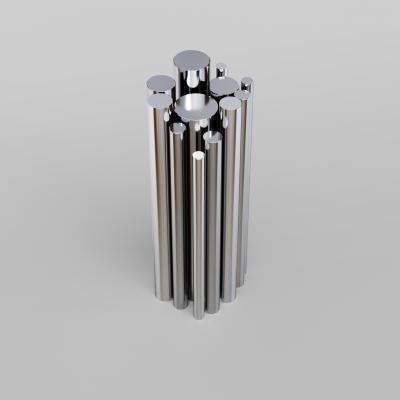
In another first, Sandvik is adding super alloy Sanicro® 625 bar (UNS 06625) to its growing family of high-performing nickel-alloys. The bar will be used to machine advanced components that are exposed to acids, alkalis, seawater and other wet corrosive conditions in both cryogenic environments and temperatures up to 593°C (1100°F).
“This is great news for customers who are looking for a reliable supply of high-quality 625 bar stock,” says Henrik Zettergren, Global Product Manager. “625 is among the toughest of nickel-based alloys and really sets the gold standard for safety, reliability and performance. When you’ve got a flange, valve or fitting that simply cannot fail, it ensures high strength, extraordinary corrosion resistance, good fabricability and excellent welding properties.”
The decision to manufacture Sanicro® 625 bar and build up local stocks with trusted distributors and at its own mills in the US, Europe and Asia was largely prompted by customers experiencing sourcing challenges during the pandemic, says Zettergren. Local stocks were (and are) often scarce, production complicated and maintaining inventory costly. Yet the need for extreme safety and reliability is high among energy producers, refineries, chemical processors and marine companies.
“We’re also seeing strong interest from geothermal power plants, solar farms, waste heat recovery plants and other renewable energy providers where molten salts, minerals and other deposits can create corrosion issues,” says Magnus Brink, a Technical Marketing Specialist. “Many tell us they also appreciate that Sandvik is making the shift towards more circular business models, reducing energy consumption, using 84% recycled steel and fossil-free energy. It’s becoming a decision-making criterion, even for bar, and a way to support our customers’ sustainability objectives.”
The new bar material, which has an ASTM classification of Grade 1, is provided in the soft annealed and quenched condition in 3 to 7-meter lengths (9.84 feet – 22.96 feet) with an outer diameter of 3 to 9 inches (76.2 to 228.6 mm). OD tolerances are +/-0.8, according to ASTM B637.
The chemical composition has a very high 62% nickel content, making Sanicro® 625 bar virtually immune to wet corrosion. A high 21% chromium content also offers superior corrosion resistance to oxidizing (acid) environments, and a high 8.5% molybdenum content ensures high resistance to pitting and crevice corrosion. Uniquely, the new addition of 3.5% niobium creates a stiffening effect with the molybdenum and provides good stabilization against intergranular corrosion. Ductility and toughness are also very high, and the material is approved by all key relevant standards (ISO, ASTM, ASTME, EN, etc.).
Sandvik will also support fabricators with machining and welding expertise and guidance through its well-known business unit Coromant, part of Sandvik Machining Solutions. Over the years, the company has built up extensive knowledge in cutting, turning and machining of nickel-based alloys.
The arrival of Sanicro® 625 bar follows the successful launch in 2021 of Sanicro® 825 (UNS N08825) bar and hollow bar, with two new high-strength grades in the pipeline (718 and 925). “This is all part of our strategy to extend the possibilities for our customers for higher safety, reliability, consistency and to drive down production costs with bar,” says Marcus Hillbom, Technical Marketing Manager. “Customers know and trust us from our tube portfolio, so this is a logical next step” he concludes.
Contact Details
Related Glossary Terms
- alloys
alloys
Substances having metallic properties and being composed of two or more chemical elements of which at least one is a metal.
- corrosion resistance
corrosion resistance
Ability of an alloy or material to withstand rust and corrosion. These are properties fostered by nickel and chromium in alloys such as stainless steel.
- ductility
ductility
Ability of a material to be bent, formed or stretched without rupturing. Measured by elongation or reduction of area in a tensile test or by other means.
- outer diameter ( OD)
outer diameter ( OD)
Dimension that defines the exterior diameter of a cylindrical or round part. See ID, inner diameter.
- outer diameter ( OD)2
outer diameter ( OD)
Dimension that defines the exterior diameter of a cylindrical or round part. See ID, inner diameter.
- pitting
pitting
Localized corrosion of a metal surface, confined to a point or small area, that takes the form of cavities.
- recovery
recovery
Reduction or removal of workhardening effects, without motion of large-angle grain boundaries.
- turning
turning
Workpiece is held in a chuck, mounted on a face plate or secured between centers and rotated while a cutting tool, normally a single-point tool, is fed into it along its periphery or across its end or face. Takes the form of straight turning (cutting along the periphery of the workpiece); taper turning (creating a taper); step turning (turning different-size diameters on the same work); chamfering (beveling an edge or shoulder); facing (cutting on an end); turning threads (usually external but can be internal); roughing (high-volume metal removal); and finishing (final light cuts). Performed on lathes, turning centers, chucking machines, automatic screw machines and similar machines.







